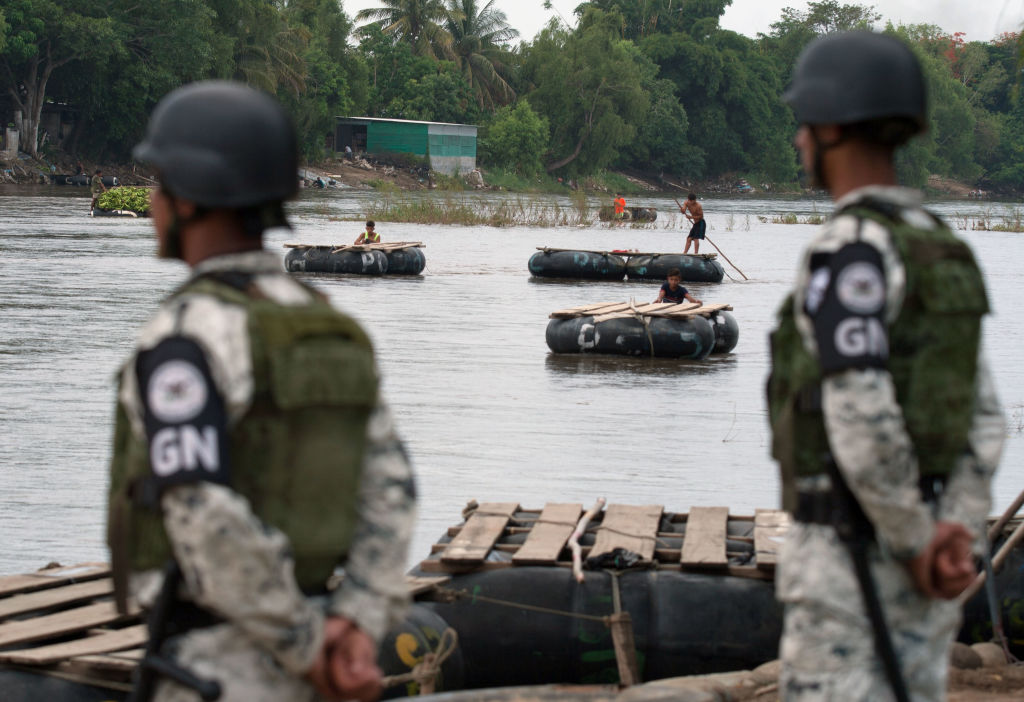
U.S. Customs and Border Protection (CBP) announced Thursday that apprehensions at the U.S. Mexico border — a figure generally considered the most accurate measure of migrants who have attempted to enter the U.S. — have decreased for the seventh consecutive month. But immigration experts and advocates say that trend is likely the result of a crackdown on migration by the Mexican government.
According to data released Thursday, 32,858 people were apprehended at the border in December 2019, including unaccompanied children, family units and adults who traveled alone. That’s a decline from the previous month that saw 33,511 apprehensions. An additional 7,762 were deemed “inadmissible” by CBP in December — which researchers say is how asylum seekers are counted by the agency — totaling 40,620 enforcement actions last month. Though numbers have steadily decreased since May 2019, apprehensions for fiscal year 2019 overall were still nearly double the year before.
CBP Acting Commissioner Mark Morgan in a public statement Thursday said that the decline is “a direct result of President Trump’s network of policy initiatives and our ability to effectively enforce the law, enhance our border security posture and properly care for those in custody.” However, border and migration experts tell TIME the reality is much more complex and is likely the result of action taken by the Mexican government, which has acted out of pressure from the Trump Administration to curb northward migration.
This is the leading reason why apprehension numbers have declined, says Josiah Heyman, professor of anthropology and director of the Center for Interamerican and Border Studies at the University of Texas at El Paso (UTEP).
“Probably a limited amount of credit — or blame — should go to the U.S. treatment of people at the border and U.S. border policy,” Heyman says. “A larger amount of the credit or blame should go to the country of Mexico doing the dirty work of the United States.”
A series of policies since the start of the Trump Administration has aimed to deter asylum claims and unauthorized migration to the U.S., including a Zero Tolerance policy that separated thousands of parents from their children. But migrants fleeing violence and poverty continued attempting to reach the U.S. border, say researchers who spoke to TIME. What has changed is their ability to reach the border.
The Mexican government — under pressure by the U.S. — has stepped up enforcement of immigration laws, resulting in the the country deploying its recently formed Mexican National Guard. The force has sometimes violently prevented migrants from arriving at the U.S. border, according to accounts my multiple Mexican media outlets. The National Guard and the Mexico office of Security and Civilian Protection did not immediately return TIME’s request for comment.
In July, U.S. President Andrés Manuel López Obrador thanked Trump for acknowledging Mexico’s efforts, according to Reuters. “I am grateful that even President Trump is making it known that Mexico is fulfilling its commitment and that there are no threats of tariffs,” Lopez Obrador said.
CBP did not immediately respond to TIME’s request for comment.
In June, Mexico announced plans to deploy thousands of National Guard forces to the northern border, and an additional 6,000 to its southern border with Guatemala in response to a threat by the Trump Administration to impose tariffs on Mexican exports to the U.S., a move that likely could have devastated the Mexican economy.
“Mexico is completely economically vulnerable to the United States,” Heyman says. “We threatened Mexico with economic disaster, and Mexico has moved in the direction of doing whatever the United States wants.”
Jeremy Slack, an assistant professor of geography in the Department of Sociology and Anthropology at UTEP who primarily studies deportation, also believes Mexico’s involvement is the leading cause of decline.
“We didn’t see a major difference in terms of what’s going on in Central America,” Slack tells TIME. “Short answer. One hundred percent, the reason for the decline is related to Mexico’s use of the National Guard to stop people traversing Mexico.”
On Friday, DHS Acting Secretary Chad Wolf spoke to reporters in Yuma, Ariz., and acknowledged Mexico’s work to combat migration northward. He called Mexico’s actions “unprecedented.”
Another policy, known as “metering,” has resulted in thousands of asylum seekers waiting in Mexico for their turn to claim asylum at a U.S. port of entry — they have not been counted in CBP’s apprehension or inadmissible statics, according to Heyman and Slack. At least an additional 56,000 have already claimed asylum but have been returned to Mexico to wait for their court proceedings.
Central Americans have also not stopped attempting to migrate north, according to Jason De León, a professor of anthropology and Chicana/o and Central American studies at the University of California, Los Angeles, who is also the director of the Undocumented Migration Project, a long-term study of unauthorized border crossing. “We have made it more dangerous to cross Mexico, and much more expensive, and we’ve prolonged the process, but people are still very much coming,” he says.
More Must-Reads from TIME
- Breaking Down the 2024 Election Calendar
- How Nayib Bukele’s ‘Iron Fist’ Has Transformed El Salvador
- What if Ultra-Processed Foods Aren’t as Bad as You Think?
- How Ukraine Beat Russia in the Battle of the Black Sea
- Long COVID Looks Different in Kids
- How Project 2025 Would Jeopardize Americans’ Health
- What a $129 Frying Pan Says About America’s Eating Habits
- The 32 Most Anticipated Books of Fall 2024
Write to Jasmine Aguilera at jasmine.aguilera@time.com